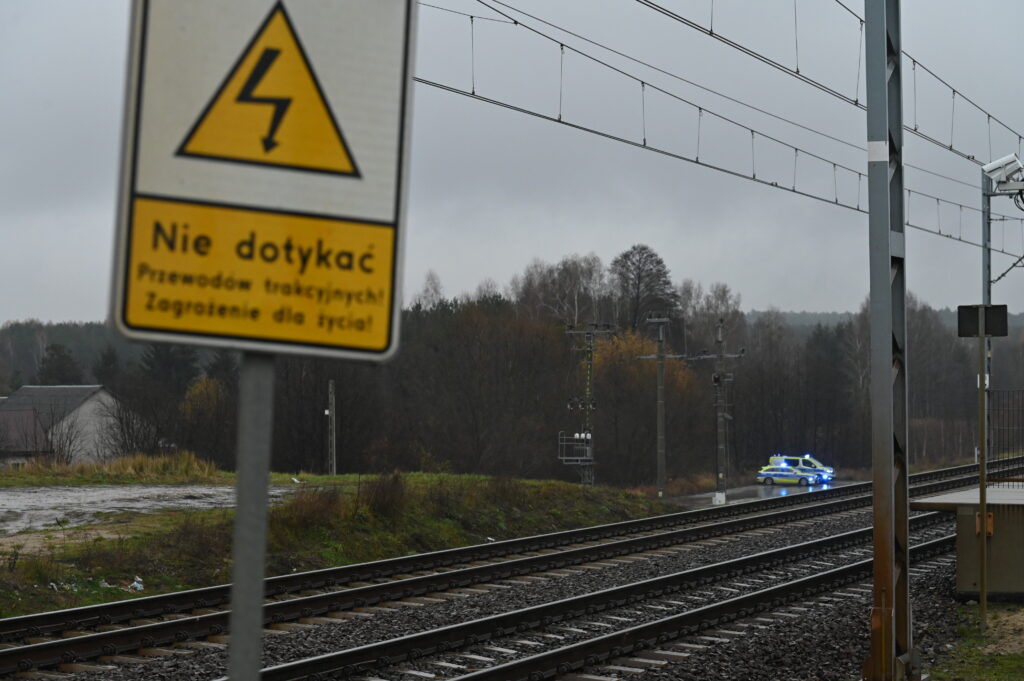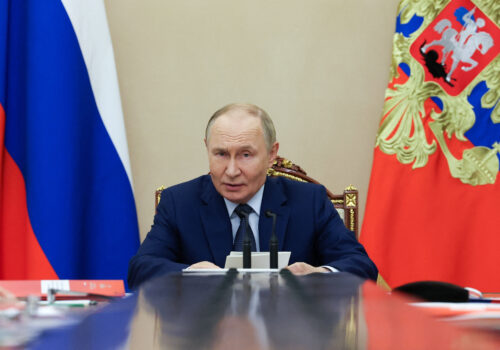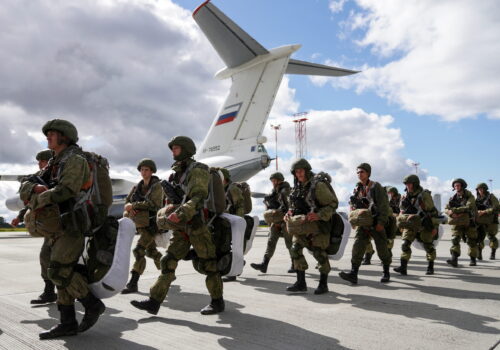WARSAW—The latest act of sabotage against European infrastructure came on November 16 in the form of explosions on a section of the rail line from Warsaw to Lublin, in eastern Poland on the way to Ukraine. On November 18, Polish Prime Minister Donald Tusk suggested that Russia, long implicated in sabotage actions in Poland, was the culprit. Polish officials and other Poles say that they regard the attack as the latest challenge from Russian President Vladimir Putin to Poland and, through Poland, to Europe and the West. And they wonder how the United States, Europe, NATO, and they themselves will respond.
Colleagues from the Atlantic Council and I spent two intense days in Warsaw this week, meeting with senior officials, former officials, entrepreneurs, executives, and experts from across Poland’s divided and contentious political spectrum. We also met with the newly arrived US Ambassador Tom Rose. This came after four days in Prague and meetings with Czech senior civilian and military officials, and with the new US Ambassador Nicholas Merrick.
News of the rail line sabotage broke the last day of our Warsaw visit. Russian sabotage and aggression against Europe—drone and fighter jet overflights; attacks against Baltic Sea cables; and various incidents in Germany, Czechia, Poland, and other countries—are not new. Everywhere we went, Poles spoke, quietly and earnestly, of the possibility of war returning to their country. Poland, like its neighbors in Central Europe, has enjoyed more than a generation of peace, democracy, and rapidly increasing prosperity. To many of the Poles we spoke with, these times may soon seem like the “before times” of wistful memory.
Russia should not have the luxury of taking action against the West without fear of countermeasures.
The Poles are neither alone nor “Russophobic” or alarmist. Senior German officials, burned and now wiser after their long and futile search for accommodation with Putin’s Russia, now speak in similar terms. The head of Germany’s intelligence service, Bruno Kahl, testified in October to the Bundestag about the possibility of a Russian attack on Europe. German Defense Minister Boris Pistorius has spoken of the possibility of open conflict with Russia as early as 2026.
What then should Europe and the United States do about this trend of actual and suspected Russian aggression? This was the question that formed the basis of many of our discussions in Warsaw and Prague.
First, Europe and the United States need to face the music. Putin is not interested in doing business with the United States or Europe except on his terms, terms that include a demand for tacit recognition of his empire acquired through war. He will not break with China; he will not do a “deal” for peace in Ukraine, except when faced with insurmountable strength. His aggression against Europe is intended to intimidate the West into stunned acquiescence while he seeks to reverse the fall of the Soviet and Russian empires.
The Trump administration has spent a lot of energy pushing for a sustainable settlement of the war in Ukraine. And rightly so. The core of the administration’s outline of a settlement could work: a cease-fire in place and security for Ukraine, with Europe in the lead but with strong US backup. But the US administration still sends mixed messages, seemingly reflecting different schools of thought within it. That won’t do. The Trump team needs to be as steady and internally united in its pushback against Putin’s aggression as it has been against Iran and other adversaries.
Second, Europe needs to get real, and fast, about doing more for its own defense. The Trump administration has often, and rightly, put that in terms of a push for greater European spending on its military. That push has met with success in the form of NATO’s agreement at its 2025 Hague summit to a target of 5 percent of gross domestic product on defense, broken down into 3.5 percent on “hard” military expenditures and 1.5 percent on associated defense spending.
But spending is an input, and the output in military capability is what matters. We spent much of our time meeting with business executives from the Czech and Polish defense sectors, talking about the rapidly changing technological challenge of new weapons such as drones and the need to move fast from a sluggish peacetime procurement cycle to rapid turnaround. That’s no abstract challenge but an immediate necessity.
Fortunately, there is good news coming from Central Europe. High-tech start-ups that move fast, working with Ukrainians to apply battlefield lessons to production, are springing up all over both countries. Some are small. Others are mid-sized and growing fast. Still others, such as one Czech company we met with, are already investing in large-scale military production, including in the United States. A Polish firm is building state-of-the art reconnaissance satellites and launching them on SpaceX rockets.
One big task for these companies is to scale up and work with their US and European counterparts to turn topline defense spending into frontline military capacity. The United States can help. The United States and Europe have been sparring over trade and risk looking at their respective defense industries on what sometimes seem like zero-sum terms. That won’t do, especially in the face of the near-term danger of Russian aggression. To use the vocabulary of the Trump administration, there are a lot of good deals to be done in the defense sector. By helping remove barriers to technology transfer, defense trade, and investment, the United States can do the right thing for common security and make good money along the way.
Third, the United States and Europe can tighten the screws on Russia’s economy. The Trump administration has finally introduced its first new Russia sanctions, on the energy giants Rosneft and Lukoil. Now the administration must enforce them. And if it turns out that Russia is behind the latest attack on Polish rail lines, the United States and Europe should scale up sanctions. A full financial embargo, with limited and defined exceptions, might be a good place to start.
Fourth, the United States and Europe should speed up provision to Ukraine of weapons to target Russian infrastructure. And they can consider asymmetrical measures to counter Russian physical sabotage. These can be covert, but Russia should not have the luxury of taking action against the West without fear of countermeasures.
Even a brief visit to Warsaw, with its history of wartime destruction, communist oppression, and present prosperity and vulnerable peace, can concentrate the mind. Poles, whatever their politics, look to the United States, whatever its politics. And the Poles are pulling their weight on defense, with other Europeans starting to do the same. Putin represents the latest incarnation of the old adversary of the twentieth century—an aggressive tyranny. He’s on the march. But countries of the free world have good options if they will take them.
Daniel Fried is the Weiser family distinguished fellow at the Atlantic Council and a former US ambassador to Poland.
Further reading
Tue, Sep 23, 2025
Putin is escalating Russia’s hybrid war against Europe. Is Europe ready?
UkraineAlert By
Putin has clearly been encouraged by Trump’s efforts to downgrade America’s involvement in transatlantic security and feels emboldened to escalate his own hybrid war against Europe, writes Maksym Beznosiuk.
Thu, Sep 18, 2025
Putin’s Polish probe demands decisive response to restore NATO deterrence
UkraineAlert By
Putin’s recent drone escalation in the skies over Poland is an unmistakable signal that NATO’s credibility is under threat. Western leaders must now respond decisively to deter further Russian aggression, writes Zahar Hryniv.
Thu, Sep 11, 2025
Belarus hosts Russian war games as Putin’s drones probe Poland
UkraineAlert By Hanna Liubakova
On September 12, Belarus and Russia will begin their largest joint military exercises since the start of Putin's Ukraine invasion, just two days after at least nineteen Russian drones penetrated neighboring Polish airspace, writes Hanna Liubakova.
Image: Police investigate at the scene of a damaged section of railway tracks on the Deblin-Warsaw route near the Mika railway station, next to the town of Zyczyn, central Poland, on November 17, 2025. Polish Prime Minister Donald Tusk says that an act of sabotage takes place, resulting in the destruction of the railway tracks by an explosive device. The damaged route is also crucial for delivering aid to Ukraine. Photo by Aleksander Kalka/NurPhoto via Reuters Connect.




